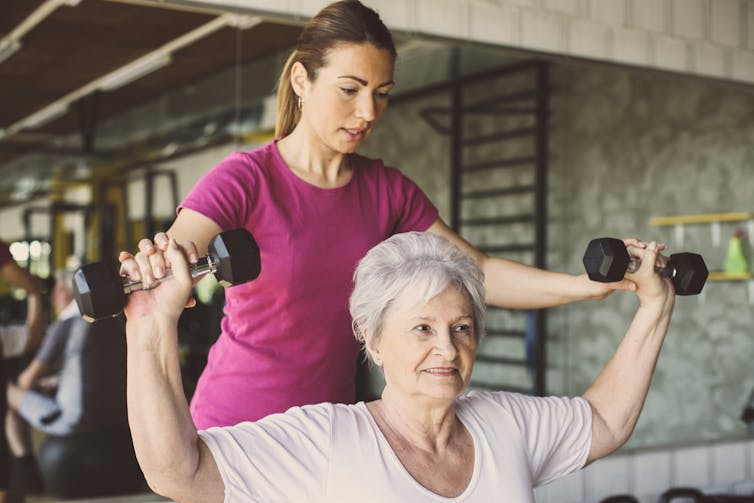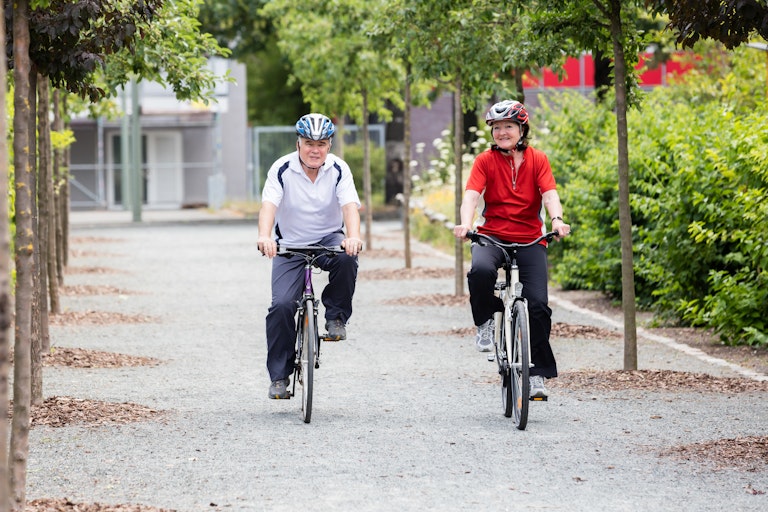We all know making physical activity a regular habit is important for health and well-being. But health promotion messages are often aimed at children and young people, with less focus on the importance of physical activity for older people. However, older age is a crucial time for being active every day.
Studies show physical activity, such as just increasing your daily number of steps, may help you live longer. This is the case even if you only started in older age. It can prevent and help to manage many health conditions including diabetes, some cancers, heart disease, and dementia.
Exercise is as effective as some medications in preventing or managing conditions such as heart disease and diabetes, and for rehabilitation after stroke. Besides the direct benefits, being more physically active can improve sleep, social connection, and overall feelings of happiness and well-being.
Read more: Health Check: in terms of exercise, is walking enough?
How much activity is enough?
Australia’s physical activity guidelines recommend people aged 65 years and over be:
…active every day in as many ways as possible, doing a range of physical activities that incorporate fitness, strength, balance and flexibility; and should accumulate at least 30 minutes of moderate intensity physical activity on most, preferably all, days.
Unfortunately, only 25% of older Australians achieve this amount of activity. As few as 12% regularly undertake strengthening activities (such as lifting weights) and 6% do balance activities (such as lunges or single-leg standing).

Doing something is better than nothing, even if achieving the amount recommended by guidelines is too difficult. Physical activity can include a range of options from exercise classes to active transport (such as cycling or walking), to gardening and home maintenance.
Starting small and building up the amount and intensity of activity, and choosing something enjoyable, are the best ways to start.
There are extra benefits from doing more than 30 minutes per day of activity. For those already participating in more vigorous activities, like running or cycling, turning 65 is no reason to stop.
Why be active?
Falls are common in older age. Around one in three people aged 65 and over fall each year. Falls often have lasting, devastating consequences for an older person and their family. Falls are not inevitable, and can be prevented with exercise that challenges balance. This means exercise performed in a standing position (rather than sitting) that usually involves movement of the body. Examples include knee squats, walking on the heels or toes, and stepping over obstacles.
Read more: Why older people get osteoporosis and have falls
Older people face particular barriers to being more physically active – these can be financial, physical, social or practical. Some older adults find electronic gadgets that help track daily physical activity useful for reminding and motivating them to be more active.
Residents of some Australian states can also access the Get Healthy service for free information, motivation and support for making healthy lifestyle changes, including physical activity. The NSW Ministry of Health funds the Active and Healthy website that includes a database of physical activity opportunities for people aged 50 years and over.
There are many options if you prefer to exercise in organised groups. Find out whether one of the Heart Foundation walking groups meets in your area – these groups are a way of keeping active in a fun and sociable way. Or for a bit more of a challenge, parkrun is a free, weekly 5km timed running (or walking) event in more than 300 locations across Australia.
What if I’m unwell?
Research shows that even people with health issues can gain a lot from being more active. For example, people with knee and hip osteoarthritis can benefit, in terms of reduced pain and improved function, from a range of physical activities. These include muscle strengthening, and aerobic and flexibility exercise, performed on land or in the water.
Similarly, people with diabetes can improve their glucose control from aerobic exercise (such as walking or swimming), muscle strengthening or a combination of both.
Read more: Do you even lift? Why lifting weights is more important for your health than you think
It’s important that frailer older people or people with particular health problems seek professional help to select physical activity options that are most suited to their particular abilities and health conditions. Such people should discuss plans to get more active with their GP, and then seek guidance from a physiotherapist or exercise physiologist.
The new World Health Organisation Global Action Plan on Physical Activity 2018-30 provides guidance on policy actions for governments and other organisations to make it easier for people to be more active. Safe, pleasant venues and leaders linked with health professionals and welcoming, enjoyable and affordable programs would help overcome barriers reported by older people.

